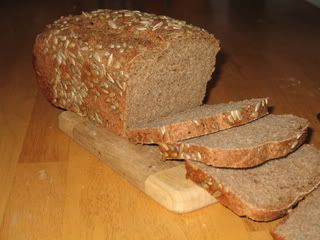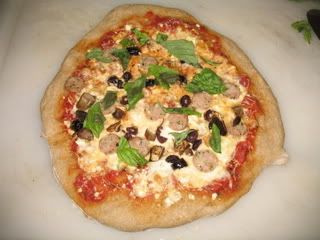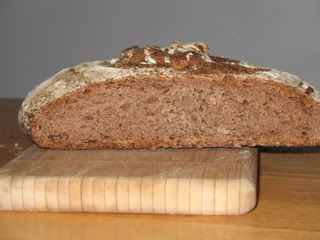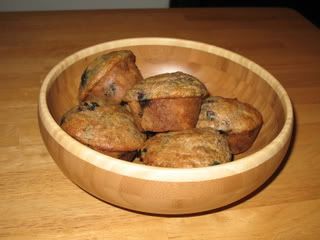Now, I'll grant you, whole wheat soybean bread garnished with sunflower seeds sounds like a parody of something you might find in The Laurel's Kitchen Bread Book. And, in fact, you won't find it there.
 Well, not with the sunflower seeds, anyway. The original recipe calls for sesame oil and sesame seeds. My daughter's preschool doesn't allow peanuts, sesame or tree nuts (one of her friends there is deathly allergic), so I had to go with sunflower seeds. Yes, it sounds like 70's health-food hell, but truly -- I kid you not -- this sandwich bread is delicious. The flavor is very warm and it keeps for a long, long time.
Well, not with the sunflower seeds, anyway. The original recipe calls for sesame oil and sesame seeds. My daughter's preschool doesn't allow peanuts, sesame or tree nuts (one of her friends there is deathly allergic), so I had to go with sunflower seeds. Yes, it sounds like 70's health-food hell, but truly -- I kid you not -- this sandwich bread is delicious. The flavor is very warm and it keeps for a long, long time.
I love The Laurel's Kitchen Bread Book. Her book taught me how to make light whole-wheat bread; without it, I'd still be churning out high-fiber doorstops. But that doesn't mean I don't think her recipes can't be improved. She's a bit light with the salt (in grams, at least -- the volumetric measurements are on the money), for instance, so I generally add a tad more to bring it up to the 1.8 to 2 percent range, and I almost always add a pre-ferement of some sort.
One other thing to remember -- if you're using cups, Laurel has a very heavy hand. Forget fluffing up the flour and spooning it in the cup. Dig deep and let it settle.
Here's how I made this bread:
The Night Before
Take 3/4 cup or 150 g raw soybeans (roughly 2 cups cooked) and cook them overnight in a slow cooker in plenty of water. If you're brave, let them simmer in a big pot with lots of water overnight -- I'm not that brave. In the morning, mash up the soybeans well.
Mix 2.5 cups or 375 g whole wheat flour with a pinch of instant yeast and 1.25 cups or 280 g water. Cover and let it ferment for 10-14 hours. By morning it should be full of bubbles.
The Next Day
2.5 cups or 375 g whole wheat flour 2.5 tsp or 17 g salt 1.5 tsp instant yeast 3 Tbs honey 1.25 cups or 280 g water 1/4 cup of sesame or other oil (I used canola) 2 Tbs lightly toasted sesame seeds (I used raw sunflower seeds)
Break up the pre-ferment into a dozen pieces and mix it with all the other ingredients except for the seeds and the soybeans. Knead the dough until you can stretch a piece of it into a thin translucent sheet without tearing. This should take anywhere from 10-20 minutes, or 300 to 600 strokes. Once the dough is nearly fully kneaded, flatten the dough and spread half of the soy pulp on top. Fold the dough up, flatten again, and spread out the other half. Knead until all the pulp is well incorporated. Then, form the dough into a ball, put it in a bowl, cover it and let it rise. When it's ready, you'll be able to poke it with a wet finger and the dough will either not spring back, or will do so very slowly. Divide the dough, form two loaves, roll the loaves in the sunflower seeds and place into greased pans. Cover and let them rise until they crest above the edge of the pans. Slash the loaves as you like, and then bake at 350 (with steam, if you like) for about 50 minutes. NOTE: Laurel directs readers to do two bulk rises and then shape. Since you've got a pre-ferment, I don't think another bulk rise will do much for the bread, but feel free to experiment.
Soybean bread wasn't the only thing I made this weekend, however. I also attempted a sourdough pizza using the no-knead technique. The dough was 1/3 whole wheat, 1/3 white bread flour and 1/3 semolina, with salt and olive oil. It was pretty wet -- about 72 percent hydration -- and had about 15% of the flour (whole wheat) in the starter. I let it sit, unkneaded for about 12 hours, folded it, and then put it in the fridge for the afternoon.
 Here's the first pizza. Turned out less than OK. Crust was chewy, not crispy, and the flavor was far too sour. The second pizza? Let me just say I'll never forget to re-flour my peel when making two pizzas EVER AGAIN. I had to set the oven on "clean" the mess was so awful, and, in the process of incinerating the mass of cheese, dough and tomato sauce that remained cemented to the oven floor, it set off my smoke alarm at 3am.
Here's the first pizza. Turned out less than OK. Crust was chewy, not crispy, and the flavor was far too sour. The second pizza? Let me just say I'll never forget to re-flour my peel when making two pizzas EVER AGAIN. I had to set the oven on "clean" the mess was so awful, and, in the process of incinerating the mass of cheese, dough and tomato sauce that remained cemented to the oven floor, it set off my smoke alarm at 3am.
I also tried to get the no-knead thing right for whole wheat: All whole wheat flour, 85% hydration, 1.8% salt, 15% starter innoculation. 12 hour rest, fold, shape, place in a well-floured (but not well floured enough) banneton and proof for 3.5 hours at 82 degrees F. Bake in a cloche, hot.
 Behold! The super sour pancake!
Behold! The super sour pancake!
But I wasn't finished. I still had about 1 cup of starter left over, and didn't want to throw it away. So I decided to make Sourdough Blueberry Muffins. The only changes I made to the recipe behind the link were to use a whole wheat starter, use whole wheat pastry flour and add 1/4 cup milk to get the right consistency. Not bad at all! Very light and not super-sweet with a simlar sourdough undertone to the sourdough waffles I made the week before. So the weekend turned out ... about 50%. Which I'll take -- maybe next week i'll get the no-knead whole wheat sourdough right. Sigh.
Here's the muffins.

 Well, not with the sunflower seeds, anyway. The original recipe calls for sesame oil and sesame seeds. My daughter's preschool doesn't allow peanuts, sesame or tree nuts (one of her friends there is deathly allergic), so I had to go with sunflower seeds. Yes, it sounds like 70's health-food hell, but truly -- I kid you not -- this sandwich bread is delicious. The flavor is very warm and it keeps for a long, long time.
Well, not with the sunflower seeds, anyway. The original recipe calls for sesame oil and sesame seeds. My daughter's preschool doesn't allow peanuts, sesame or tree nuts (one of her friends there is deathly allergic), so I had to go with sunflower seeds. Yes, it sounds like 70's health-food hell, but truly -- I kid you not -- this sandwich bread is delicious. The flavor is very warm and it keeps for a long, long time. I love The Laurel's Kitchen Bread Book. Her book taught me how to make light whole-wheat bread; without it, I'd still be churning out high-fiber doorstops. But that doesn't mean I don't think her recipes can't be improved. She's a bit light with the salt (in grams, at least -- the volumetric measurements are on the money), for instance, so I generally add a tad more to bring it up to the 1.8 to 2 percent range, and I almost always add a pre-ferement of some sort.
One other thing to remember -- if you're using cups, Laurel has a very heavy hand. Forget fluffing up the flour and spooning it in the cup. Dig deep and let it settle.
Here's how I made this bread:
The Night Before
Take 3/4 cup or 150 g raw soybeans (roughly 2 cups cooked) and cook them overnight in a slow cooker in plenty of water. If you're brave, let them simmer in a big pot with lots of water overnight -- I'm not that brave. In the morning, mash up the soybeans well.
Mix 2.5 cups or 375 g whole wheat flour with a pinch of instant yeast and 1.25 cups or 280 g water. Cover and let it ferment for 10-14 hours. By morning it should be full of bubbles.
The Next Day
Break up the pre-ferment into a dozen pieces and mix it with all the other ingredients except for the seeds and the soybeans. Knead the dough until you can stretch a piece of it into a thin translucent sheet without tearing. This should take anywhere from 10-20 minutes, or 300 to 600 strokes. Once the dough is nearly fully kneaded, flatten the dough and spread half of the soy pulp on top. Fold the dough up, flatten again, and spread out the other half. Knead until all the pulp is well incorporated. Then, form the dough into a ball, put it in a bowl, cover it and let it rise. When it's ready, you'll be able to poke it with a wet finger and the dough will either not spring back, or will do so very slowly. Divide the dough, form two loaves, roll the loaves in the sunflower seeds and place into greased pans. Cover and let them rise until they crest above the edge of the pans. Slash the loaves as you like, and then bake at 350 (with steam, if you like) for about 50 minutes. NOTE: Laurel directs readers to do two bulk rises and then shape. Since you've got a pre-ferment, I don't think another bulk rise will do much for the bread, but feel free to experiment.
Soybean bread wasn't the only thing I made this weekend, however. I also attempted a sourdough pizza using the no-knead technique. The dough was 1/3 whole wheat, 1/3 white bread flour and 1/3 semolina, with salt and olive oil. It was pretty wet -- about 72 percent hydration -- and had about 15% of the flour (whole wheat) in the starter. I let it sit, unkneaded for about 12 hours, folded it, and then put it in the fridge for the afternoon.
 Here's the first pizza. Turned out less than OK. Crust was chewy, not crispy, and the flavor was far too sour. The second pizza? Let me just say I'll never forget to re-flour my peel when making two pizzas EVER AGAIN. I had to set the oven on "clean" the mess was so awful, and, in the process of incinerating the mass of cheese, dough and tomato sauce that remained cemented to the oven floor, it set off my smoke alarm at 3am.
Here's the first pizza. Turned out less than OK. Crust was chewy, not crispy, and the flavor was far too sour. The second pizza? Let me just say I'll never forget to re-flour my peel when making two pizzas EVER AGAIN. I had to set the oven on "clean" the mess was so awful, and, in the process of incinerating the mass of cheese, dough and tomato sauce that remained cemented to the oven floor, it set off my smoke alarm at 3am. I also tried to get the no-knead thing right for whole wheat: All whole wheat flour, 85% hydration, 1.8% salt, 15% starter innoculation. 12 hour rest, fold, shape, place in a well-floured (but not well floured enough) banneton and proof for 3.5 hours at 82 degrees F. Bake in a cloche, hot.
 Behold! The super sour pancake!
Behold! The super sour pancake! But I wasn't finished. I still had about 1 cup of starter left over, and didn't want to throw it away. So I decided to make Sourdough Blueberry Muffins. The only changes I made to the recipe behind the link were to use a whole wheat starter, use whole wheat pastry flour and add 1/4 cup milk to get the right consistency. Not bad at all! Very light and not super-sweet with a simlar sourdough undertone to the sourdough waffles I made the week before. So the weekend turned out ... about 50%. Which I'll take -- maybe next week i'll get the no-knead whole wheat sourdough right. Sigh.
Here's the muffins.

- JMonkey's Blog
- Log in or register to post comments
The whole wheat bread looks lovely!
I had not considered sunflower seeds in bread before but I am tempted now! I like, what my mom calls, birdseed breads! I really love a recipe for honey wheat berry bread I found, but I always add some 7 grain cereal to it for added whole grain punch. I am thinking sunflower seeds may be a new fun option!!
Toasted millet is nice too. Very pretty in the loaf, and it adds a nice, but not tooth-breaking, crunch.
This was a really big loaf, since I just made a regular batch of buttermilk bread and then added in the oatmeal and other goodies. I think each loaf checked in at well over 2 pounds, though the texture was light. A bit too big for my bread box, so I scale it down now.
What nice bread! I have an oatmeal bread recipe from my grandmother that I like pretty well. I have made it with dried cranberries (rehydrated slightly in hot orange juice so the berries do not steal my breads water) with great success. I am not much for raisins, but pecans I like and I think pecans and cranberries would be really good! Thanks for the tip! I have also had success with diced apple in the oatmeal and in the honey wheat breads. Add a dash of cinnamon and your in business at breakfast time ... or for some really killer french toast.
> Now, I'll grant you, whole wheat soybean bread garnished
> with sunflower seeds sounds like a parody of something
> you might find in The Laurel's Kitchen Bread Book
I would strongly urge everyone here to read Unhappy Meals: The Age of Nutritionism in the 2007/01/28 New York Times Magazine (note that this link may not work for long as the NYT pulls things behind a paywall after x days). The author is Michael Pollen, author of The Omnivore's Dilimma. This article is by far the best statement of how food affects us that I have ever read (and unfortunately, I have had to read more of that stuff in the last two years than I would have liked).
sPh
... and the heart of the article...